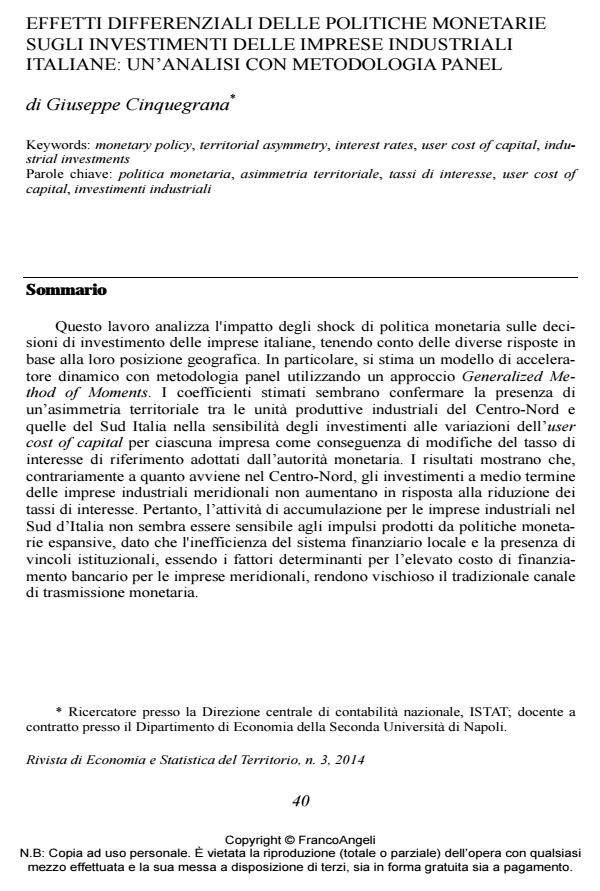Differential effects of monetary policy on the investments of Italian industrial firms: a panel analysis
Journal title RIVISTA DI ECONOMIA E STATISTICA DEL TERRITORIO
Author/s Giuseppe Cinquegrana
Publishing Year 2015 Issue 2014/3
Language Italian Pages 39 P. 40-78 File size 232 KB
DOI 10.3280/REST2014-003002
DOI is like a bar code for intellectual property: to have more infomation
click here
Below, you can see the article first page
If you want to buy this article in PDF format, you can do it, following the instructions to buy download credits

FrancoAngeli is member of Publishers International Linking Association, Inc (PILA), a not-for-profit association which run the CrossRef service enabling links to and from online scholarly content.
This work analyses the impact of monetary policy shocks on the investment decisions of Italian firms, taking into account different responses according to their geographic location. Method and Results. We estimate an accelerator dynamic panel model using a Generalized Method of Moments approach. The estimated coefficients seem to confirm the presence of a territorial asymmetry between the productive industrial units of the Centre-North and the ones of the South of Italy in the investments’ sensitivity to the variations in the user cost of capital for each firm as consequence of changes in the reference interest rate adopted by monetary Authority. The results show that, contrary to what happens in the Centre-North, the medium term investments of Southern industrial firms do not increase in response to the reduction of the interest rates. Conclusions. Thus, the activity of accumulation for industrial enterprises in the South of Italy does not seem to be sensitive to the pulses produced by expansionary monetary policies, since the inefficiency of the local financial system and the presence of institutional constraints, being the determining factors for the high cost of bank financing for southern firms, make it sticky the traditional channel of monetary transmission.
Keywords: Monetary policy, territorial asymmetry, interest rates, user cost of capital, industrial investments
Jel codes: E52-C10-R10-D22
- The Fruits of Disaggregation: The Engineering Industry, Tariff Protection, and the Industrial Investment Cycle in Italy, 1861-1913 Stefano Fenoaltea, in SSRN Electronic Journal /2017
DOI: 10.2139/ssrn.3082189
Giuseppe Cinquegrana, Effetti differenziali delle politiche monetarie sugli investimenti delle imprese industriali italiane: un’analisi con metodologia panel in "RIVISTA DI ECONOMIA E STATISTICA DEL TERRITORIO" 3/2014, pp 40-78, DOI: 10.3280/REST2014-003002